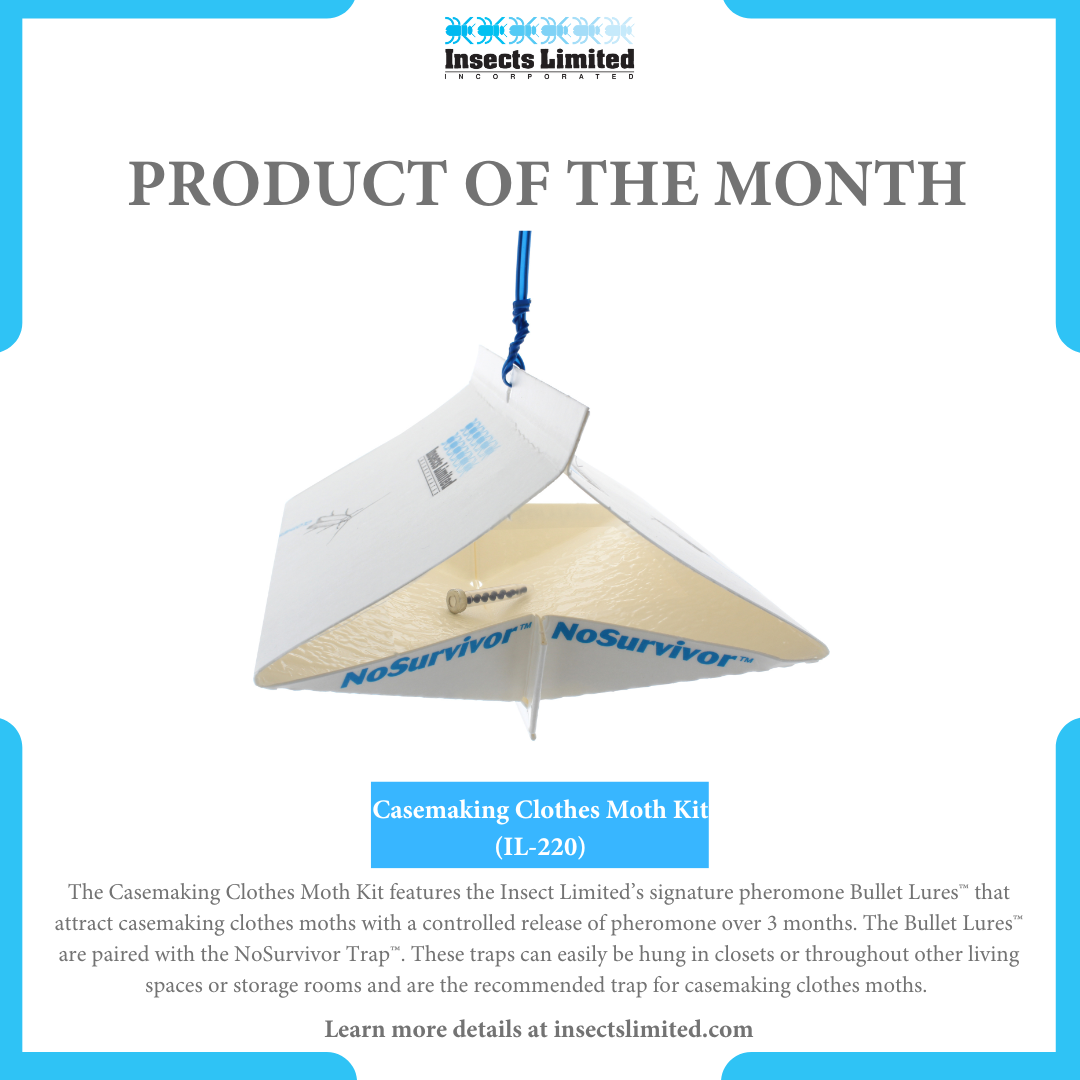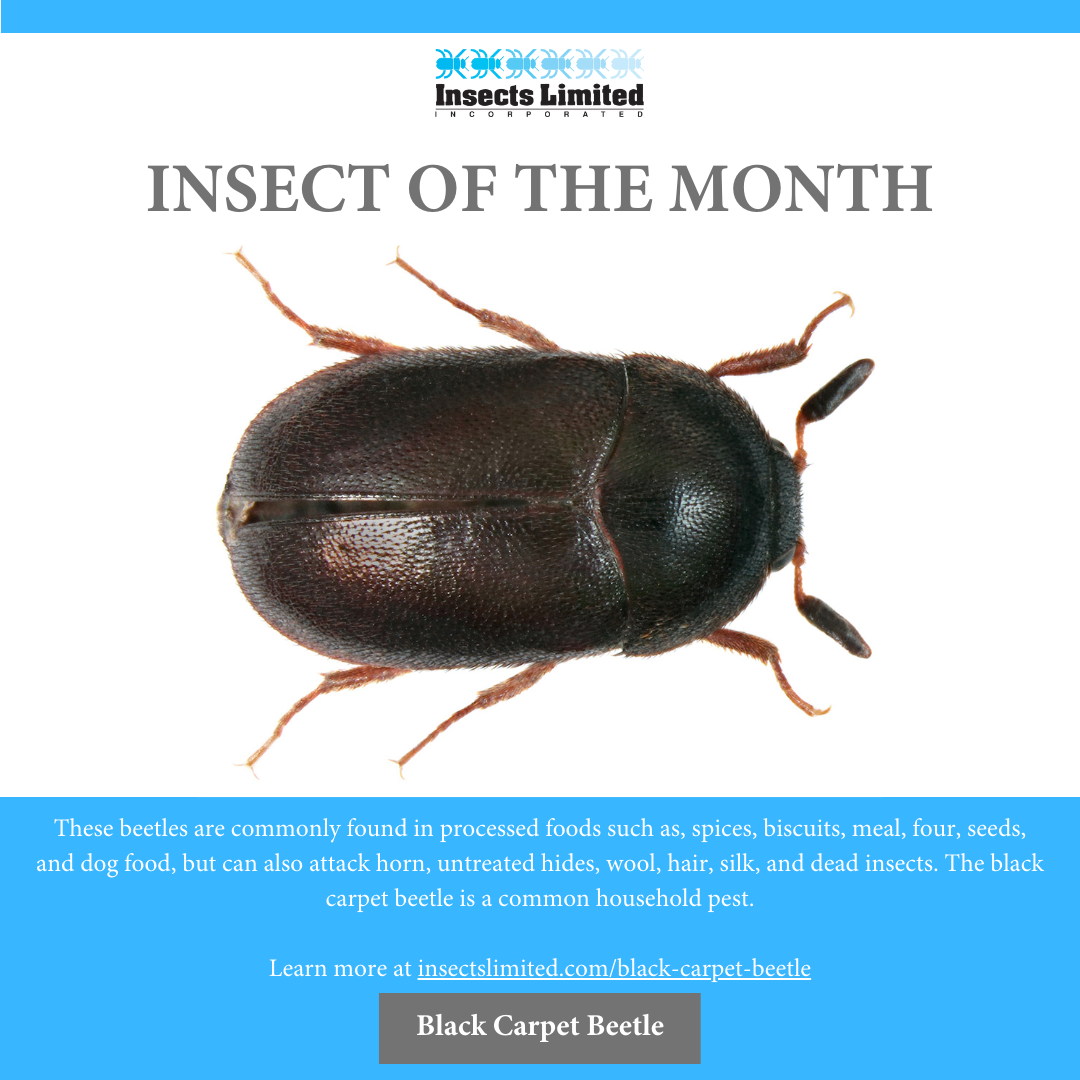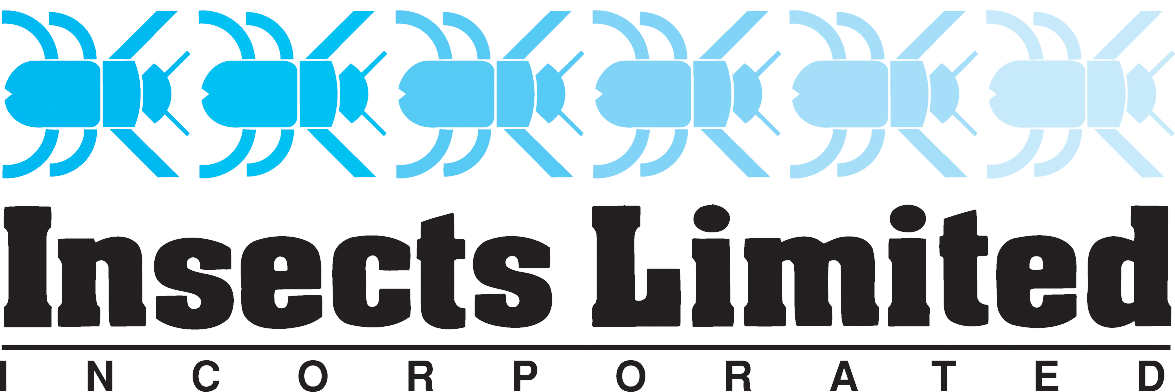
Clothes Moth History and Damage
Clothes moths have been a serious insect pest for thousands of years causing damage to clothes, furnishings, and other items made from animal materials like wool, fur, and feathers.

Meet Samantha Kiever - Insects Limited’s Newest Research Entomologist
Insects Limited is excited to announce the addition of a new staff entomologist joining our Research and Development department. After receiving her degree in entomology, Samantha (Sam) Kiever has joined the Insects Limited team, filling a role as a Research Assistant.

Product of the Month: All Beetle Trap Kit with RTU Gel Cartridge (IL-2750)
This All Beetle Trap Kit includes complete three-part All Beetle traps and multi-species beetle and moth attractants in a pheromone gel to monitor for the presence of food-infesting insects.

Insect of the Month: Lesser Grain Borer (Rhyzopertha dominica)
The Rice Weevil larvae do the greatest amount of damage as they The lesser grain borer is a primary pest of whole grains, especially corn and cassava root.
The adults chew small holes in the kernel and then lay several eggs in the grain or in the grain mass.
Damage is seldom noticed until exit holes appear and adults are seen roaming the grain mass.

Watch: 100 Rice weevils cause damage to pasta over 6 months
Rice and maize weevil (Sitophilus oryzae and zeamais) can cause major damage to stored grains and processed foods. Their movement through food can spread and encourage mold germination and their excrement leaves behind uric acid that can cause rancidity.
Following the theme this month, this video shows a time-lapse GIF of 100 rice weevils in pasta over a 6-month period at 82F (28C) and at 60% relative humidity. It is important to monitor for rice and maize weevil activity to help prevent populations from damaging products and causing customer complaints.

Product of the Month - All Beetle Rice Weevil Kit (IL-700)
This Rice Weevil kit combines the power of Insects Limited’s signature Bullet™ Lures for Rice Weevil, Sitophilus oryzae, with the innovation of the three-part All Beetle Trap™

Insect of the Month: Rice Weevil (Sitophilus oryzae)
The Rice Weevil larvae do the greatest amount of damage as they eat the inside of grains and seeds, leaving only a husk behind. The adults also have strong chewing mouthparts and will cause damage as well. Detection can be difficult in grains that have recently had eggs laid in them.
After some time, the damage becomes evident as the grains become so light and hollow, that you can easily break them into dust with your fingertips. In heavy infestations, chewing can sometimes be heard.

Watch: Clothes Moth Identification
This guide breaks down the differences between webbing clothes moths and casemaking clothes moths. Clothes moths of both species feed on wool, fur, feathers, mohair, animal hair and other animal fibers. They can infest museums, homes, and businesses.

Product of the Month - Casemaking Clothes Moth Kit (IL-220)
The Casemaking Clothes Moth Kit (IL-220-10) features the Insect Limited’s signature pheromone Bullet Lures™ that attract casemaking clothes moths with a controlled release of pheromone over 3 months.

Insect of the Month: Casemaking Clothes Moth (Tinea pellionella)
Casemaking clothes moth larvae damage woolens, silks, furs and materials made with hair and feathers. The primary means of detection of casemaking clothes moth is the presence of silken cases that contain larvae.
Granular frass, the size of ground pepper, can be found in, on, and under fabric, furs, taxidermy mounts, hanging clothes in closets, rugs, carpets, and upholstered furniture.

Watch: Silverfish Damage to Books and Archives
Silverfish commonly cause damage to books, archives and paper as well as a wide range of other materials. They can be a nightmare to librarians, archivists, museum professionals and to people in their homes.

Product of the Month - GreenWay Spider and Silverfish Trap
Captures spiders and silverfish plus many other crawling insects. Spiders and silverfish can be found in areas with high humidity levels, such as bathrooms, basements, attics, laundry rooms, and beneath sinks.

Insect of the Month: Common Silverfish (Lepisma saccharina)
Silverfish and firebrats are placed in the order Thysanura which is considered one of the most primitive of the living insect orders.
There are four species considered common in North America; the Firebrat (Thermobia domestica), the Common Silverfish (Lepisma saccharina), the Gray or Longtailed Silverfish (Ctenolepisma longicaudata), and the Four-Lined Silverfish (Ctenolepisma quadriseriata).

Clothes Moth Management
Webbing clothes moths belong to the family Tineidae which contains over 3,000 species and is collectively known as the clothes moth or fungus moth family. Many moth species in the Tineidae family look very similar to one another. In many cases, proper identification requires dissection of the abdomen to view the genitalia structure to determine the exact species.

Watch: Black Carpet Beetle Life and Feeding Habits
Black carpet beetles can be a serious pest of wool carpets and rugs but can also be a pest of dried food goods. Pheromone monitors can assist in locating the feeding sources of this pest so control can be achieved. Keys to identifying the larvae and adults as well as an explanation of their life history and feeding habits are covered in this video by entomologist Patrick Kelley.

Black Carpet Beetle, Attagenus unicolor: A Pest of Carpets and Dried Food
When the common name of an insect includes what it likes to eat, (think clothes moths, flour beetles, saw-toothed grain beetles, etc.) you know that those items are particularly at risk of being eaten by that specific species. While carpets made from wool are a fond food source for black carpet beetle larvae, carpets are only one menu item in a long list of potential foods for this pest. Somewhat surprising to many is that black carpet beetles are a common pest on grain-based, dried food goods.

Product of the Month - Black Carpet Beetle Flat Trap Kit
Black Carpet Beetle kits feature Insect Limited’s signature pheromone Bullet Lures™ that attract Black Carpet Beetle adult males with a controlled release of pheromone over a 3-month period.

Insect of the Month: Black Carpet Beetle (Attagenus unicolor)
Black Carpet Beetles are commonly found in processed foods such as, spices, biscuits, meal, four, seeds, and dog food, but can also attack horn, untreated hides, wool, hair, silk, and dead insects. The black carpet beetle is a common household pest.
Only larvae cause damage to plant or animal products or textiles. The presence of cast skins is usually apparent. Holes and frayed fibers in textiles also may be present.

Product of the Month - Food Moth NoSurvivor Kit (IL-164)
The Food Moth kit features Insect Limited’s signature pheromone Bullet Lures™ that attract multiple species of food moths with a controlled release of pheromone over 3 months.

Implementing a Pheromone Monitoring Program
Grain storage, food processing, warehousing, retail facilities, and residential houses are far too diverse to expect a single set of pheromone monitoring recommendations to be adequate. Here are 4 fundamental questions to ask when developing a pheromone monitoring program
